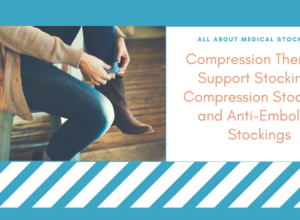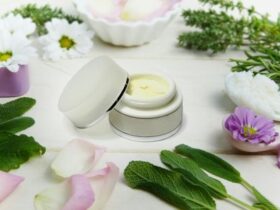Compression therapy is a treatment based on the principle of applying graduated pressure on an affected limb with the help of an elastic garment. Compression therapy often decreases venous pressure, prevents venous stasis and impairments of venous walls, and relieves heavy and aching legs. Knee-high compression stockings are used not only to help increase circulation but also to help prevent the formation of blood clots in the lower legs.
Wearing compression stockings is a simple and effective way of improving blood flow through the limbs. It is useful in treating conditions like tired and achy legs, swelling in the limbs, chronic venous insufficiency, phlebitis, varicose veins, healed or active venous ulcers, and lymphedema.
Compression therapy is also useful during long-distance travel to avoid blood clotting complications.
Benefits of Compression Therapy
Compression stockings are perfect for those people who spend their time in sedentary sitting or standing positions. It aids in problems such as:
- Venous insufficiency
- Active venous ulcers
- Post-thrombotic syndrome
- Deep vein thrombosis (DVT)
- Varicose veins
- Lymphedema
- Edema
How Compression Therapy Works-
Compression therapy encourages the blood in the veins to flow back from the foot to the heart by exerting pressure on the legs. The pressure is the highest in the ankle and decreases in the direction of the heart. This accelerates the return circulation to the heart, and the blood circulation in the leg is significantly improved. They are tightest at the ankle, with the compression decreasing strength up the leg. The blood is thereby effectively guided away from the feet and towards the heart. This, in turn, allows for fresh oxygenated blood to flow from the heart into the legs. In this way, graduated compression socks aid in the pumping of blood throughout the feet and legs.
Different Types of Compression Stockings-
There are three different types of medical-purpose stockings.
- Medical compression stockings
- Support stockings
- Anti-embolism stockings (TED stockings)
Difference Between Medical Compression Stockings, Support Stockings and Anti Embolism Stockings (TED Stockings)
Confusion can surround the selection of compression therapy stockings. On the surface, the concepts of support stockings, medical compression stockings, and specifically designed anti-embolism stockings seem similar to each other. Unfortunately, some differences make them not as interchangeable to the naked eye.
Support Stockings
Healthy individuals wear support stockings as a precautionary measure against venous problems. They are thinner in compared to compression stockings and the pressure on the leg is not as high as with compression stockings. Nevertheless, they actively support the blood flow in the legs. They are optically indistinguishable from normal stockings and are recommended especially for all activities involving prolonged sitting or standing or during long flights or car journeys.
Medical Compression Stockings
Medical compression stockings are generally prescribed by doctors for therapeutic purposes in the case of venous disease. Compression socks and stockings are best suited for patients who are not bedbound and are able to move around. By increasing blood circulation, they are appropriate for treating and preventing a range of circulatory problems such as venous insufficiency, lymphedema, and varicose veins. For some patients, this can be a temporary condition during pregnancy. Graduated compression means that they are tightest around the ankle and gradually ease as they go up, for example. Compression levels range from as little as 8-15 mmHg to all the way up to 60 mmHg. The most common compression strengths are 15-20 mmHg and 20-30mmHg (above 20 mmHg is considered prescription strength).
The correct choice is made by taking precise measurements of the patient’s legs. On the basis of his diagnosis, the physician determines the compression class as well as the specific application. Medical compression stockings guarantee a specifically defined and appropriate level of pressure on the dilated veins of the legs is exerted and a therapeutic distribution of pressure is achieved. They keep blood from pooling in the ankles, where the pressure is the greatest. They can be worn for up to six months or more on a long-term daily basis.
Who can wear Graduated Compression Stockings?
One of the more popular applications is against the development of varicose or spider veins. Graduated compression socks are commonly worn by those who spend a lot of time on their feet. Compression Stockings can help reduce the risk of DVT or spider veins in patients who travel by plane or car and reduce symptoms such as leg swelling (edema), aching, heaviness, fatigue, and pain from varicose veins. By promoting a healthy circulation of blood, the blood vessels in the legs are less likely to bulge and show through the skin. For example, compression socks for nurses and flight attendants are very popular. Ladies who have undergone C-Section (Caesarean section) can also wear compression stockings. They assist in the reduction of muscle fatigue and exhaustion and reduce the likelihood of having heavy and tired feeling legs.
Compression stockings are recommended during pregnancy to reduce pooling of blood and swelling in the feet. Athletes also find graduated compression socks to be an effective means of boosting their performance. They believe that the increased blood circulation not only provides muscles with increased levels of oxygen, which acts as fuel, but also assists in recovery and reduced downtime.
You may need to wear them on both the legs or on just one leg. Ideally, you should wear your compression stockings during the day and take them off at night before going to sleep.
Who should not Wear Compression Stockings?
Anti-embolism Stockings are not recommended for patients with the following:
- Local leg condition such as dermatitis, immediate post-operative vein ligation, gangrene or recent skin graft.
- Severe arteriosclerosis or other ischemic vascular disease.
- Massive edema (swelling) of legs or pulmonary edema from congestive heart failure.
- Extreme deformity of leg.
Compression socks and stockings are available as either knee or thigh length, however they can also be purchased as ankle length and full length. A huge variety colors and styles are available for fashion-conscious people.
Anti Embolism Stockings (TED Stockings)
Anti-embolism stockings are also known as TED stockings- Thrombo-Embolic Deterrent. They are primarily designed for the prevention of venous thromboembolisms (threat of blood clots forming in the legs) in bed-confined patients.
Anti-embolism stockings are usually white. This makes them easy to differentiate from other styles of compression stockings. They also often have a hole in the toe area, making it easier for medical staff to inspect the patient. They are available in both knee and thigh length varieties, and generally last for up to 3 weeks.
Who Should Wear Anti-Embolism Stockings?
Since non-ambulatory patients wear these, the saying goes, “TEDs are for beds.” TED hose are often prescribed to patients who spend 95% of their time immobile. They are most effective for people who are confined to bed recovering from surgery. By being immobile for an extended time, these people have poor blood circulation especially in the legs. This puts them at a much higher risk of developing venous thromboembolism or DVT. TED compression socks are able to increase blood circulation during this period of inactivity to reduce any risk.
Who Should Not Wear Anti-Embolism Stockings?
Anti-Embolism stockings are not intended for those who are able to stand and move around. They are not graduated compression and only offer about 8-18mmhg compression. TED hose do not offer sufficient support to counter the effects of gravity. They do not help the symptoms of venous disease and varicose veins. TED hose cannot be used for vein treatment or for daily support in walking patients.
How Do TED Hose Work?
Anti-embolism stockings are effective in curing Thromboembolism, edema and phlebitis. Venous Thromboembolism (VTE) is a blood clot in the vein. When the blood clot is formed in deep veins of the legs it is called Deep Vein Thrombosis. If the clot somehow travels and reaches the lungs it is called as Pulmonary Embolism. Anti-embolism stockings improve blood circulation in the leg veins by applying graduated compression of 8–18mmHg. Most of the compression occurs at the ankle or calf muscles and decreases in strength up the leg. Their purpose is to promote the circulation of blood in and around the legs. By decreasing compression strength up the leg, blood is encouraged to flow toward the heart.
When Should Anti-Embolism Stockings be Applied?
Your stockings should be changed every 2-3 days. Change (fabric sheerness) should fall between one and two inches below the bend in the knee. When compression stockings are recommended after surgery, patients are usually advised to wear them as much as possible, day and night, until they’re able to move around freely.
Cleaning and Caring of Stockings
Clean it frequently enough to remove the natural bodily secretions and skin flakes, which if you let it remain may cause the damage to stockings fiber and decrease the life span of the garment. You should choose two stockings keeping in mind that you are wearing one and other is on reserve that you can wear when you are washing what you are currently wearing. Hand wash your stockings at about 40 °C /104F (comfortable hand temperature) and dry them away from direct heat in the air.
Buying TED Compression Stockings
There are many inexpensive varieties of TED compression stockings. Keep in mind, if you are purchasing TED compression socks for home use you will need to replace each pair after a couple of weeks. In addition, if your TED hose compression socks require washing, it is recommended that you have a second pair as a backup to provide continuity of compression while you wash the dirty hose.

Dr. Haseena Hamdani, MBBS, DGO, PGD Endocrinology and Diabetes (USW) is a Gynaecologist, currently practicing in Gaborone, Botswana since the last 17 years. Prior to setting up this clinic she worked in India as well as in Zambia, as a Gynaecologist and Obstetrician and was also associated with an Infertility center. She is also an online tutor for the University of South Wales.













Leave a Reply